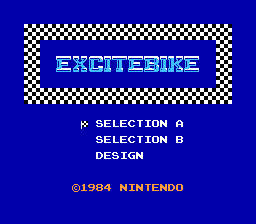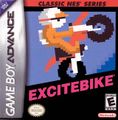
Excitebike was one of the more popular launch titles for the NES, but it's popularity was due in large part to the games presence in arcades. Among all of Nintendo's Vs. arcade titles, Excitebike was one of the most common, appearing more frequently than even Vs. Super Mario Bros. This is largely due to the fact that when arcade owners were given the choice between an easy to understand motorcross racing game or a strange adventure about a plumber who eats mushrooms to grow in size, they went with the concept that made the most sense to them.
Excitebike, though primative by todays standards, builds its gameplay, and subsequently its popularity, on a pure game design concept. There is no backstory or integral characters to know. The player merely assumes the role of a motorbike racing contestant whose aim is to become the champion. The controls are simple and intuitive, and the experience is fun, as you guide your bike over ramps and jumps, and trip up the competition.
When Excitebike was programmed for the Famicom, it including a track edit mode where players could design and play on their own tracks. These tracks were saved on the Famicom cassette recorder that was also used with Famicom BASIC. When the game was released outside of Japan, the edit mode remained, but there was no way to physically save the tracks. Vs. Excitebike was released in the arcade shortly after the Famicom release, partially in an attempt to create a demand for the home version in the United States. The Vs. version was later released on the Famicom Disk System with some improved features, including a two player mode that the original game lacked (each player took turns), and an improved track save system (the tracks were saved to the writable portion of the disk). The original game was published for the Game Boy Advance e-Reader card system (without the track save feature), and then again as part of the Classic NES/Famicom Mini series of NES games on the GBA with the ability to save one track.
-
Famicom
-
Game Boy Advance Classic NES
-
Game Boy Advance Famicom Mini
-
e-Reader cards wrapper




